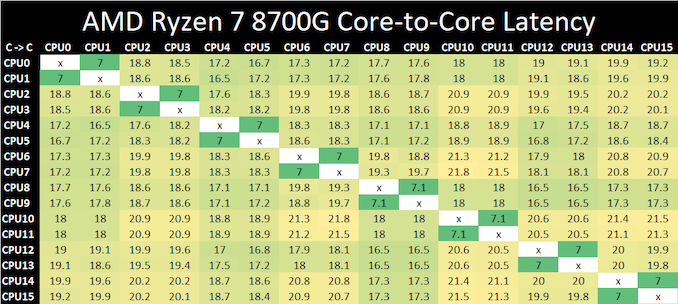AMD Ryzen 7 8700G and Ryzen 5 8600G Review: Zen 4 APUs with RDNA3 Graphics
by Gavin Bonshor on January 29, 2024 9:00 AM EST- Posted in
- CPUs
- AMD
- APUs
- Phoenix
- 4nm
- Zen 4
- RDNA3
- AM5
- Ryzen 8000G
- Ryzen 7 8700G
- Ryzen 5 8600G
Core-to-Core Latency
As the core count of modern CPUs is growing, we are reaching a time when the time to access each core from a different core is no longer a constant. Even before the advent of heterogeneous SoC designs, processors built on large rings or meshes can have different latencies to access the nearest core compared to the furthest core. This rings true especially in multi-socket server environments.
But modern CPUs, even desktop and consumer CPUs, can have variable access latency to get to another core. For example, in the first generation Threadripper CPUs, we had four chips on the package, each with 8 threads, and each with a different core-to-core latency depending on if it was on-die or off-die. This gets more complex with products like Lakefield, which has two different communication buses depending on which core is talking to which.
If you are a regular reader of AnandTech’s CPU reviews, you will recognize our Core-to-Core latency test. It’s a great way to show exactly how groups of cores are laid out on the silicon. This is a custom in-house test, and we know there are competing tests out there, but we feel ours is the most accurate to how quick an access between two cores can happen.
Looking at core-to-core latencies of the AMD Ryzen 7 8700G, as this is a monolithic Phoenix die, we can see good inter-core latencies between each of the eight individual Zen 4 cores. Going within the core, we can see solid latencies of 7ns, while things inter-core range between 17 and 21ns, showing that the Ryzen 7 8700G uses a single core cluster of eight cores.
Similar to what we've seen on previous iterations of Zen 4 and Zen 3, albeit on processors with multiple core complex (CCXs) such as the Ryzen 9 7950 and Ryzen 9 5950X, inter-core latencies are strong and low. In contrast, the Ryzen 7 8700G and other Ryzen 8000G monolithic chips on a single die remove the complications and penalties of connecting through AMD's Infinity Fabric interconnect. The Ryzen 7 8700G uses TSMC's refined 4nm manufacturing process, exactly the same as the Ryzen 7040 mobile, which is coincidentally the exact same design as the 8700G, given that AMD has repurposed Phoenix for use on AMD's AM5 desktop platform.
The core-to-core latency performance is inherently strong on the Ryzen 7 8700G, with low inter-core latencies. As expected, latency degrades a little going across the entire complex, but certainly not within the range where we would expect these penalties to cause latency issues when cores have to communicate with each other.











111 Comments
View All Comments
goatfajitas - Monday, January 29, 2024 - link
Whoa, 428 watts at peak for the i9-14900K? I have not paid close attention to the last few rounds of releases and I knew it was bad but wholly crap. WTF Intel?jrbales@outlook.com - Monday, January 29, 2024 - link
Yeah, they definitely get pretty toasty, of it's imperative to plan out a cooling strategy to keep the CPU and other components from roasting. Of course, it does allow you to use it as a space heater in addition to a computer in cold weather. The highest TDP Ryzen 7000 CPUs run "cool" by comparison.goatfajitas - Monday, January 29, 2024 - link
Yes, it would make a good "Winter PC" LOLshabby - Monday, January 29, 2024 - link
Are they available in russia? They need them desperately to heat their frozen homes 😂GeoffreyA - Tuesday, January 30, 2024 - link
Maybe the US should donate a few out of the kindness of their hearts.ricebunny - Monday, January 29, 2024 - link
Peak power is an irrelevant metric. It’s more of a motherboard feature than anything else - Intel’s Raptor Lake will pull as much power as you give them.For those who are concerned about power, there is a TDP ceiling feature. Once set, the Intel CPU will adhere closely to the limit. Laptop tests have shown the Intel Raptor Lake to be about as power efficient as the Zen 4. Take a look at Ars’s review of Framework 13.
goatfajitas - Monday, January 29, 2024 - link
It is not irrenevant and is not a mobo feature. It is how much power is drawn under heavy load. When under heavy load for short bursts it can be fine, but under sustained load, it will get too hot and therefore not operate at or near turbo, it will run closer to the base clock, which is lame.TheinsanegamerN - Tuesday, January 30, 2024 - link
You are ignorant. A 14900k will shovel gobs of power if you let it. Set it to a 250 watt TDP and it will stick to 250 watt while losing MAYBE 2% peak performance.Turbo isnt SUPPOSED to be sustained, that's a MOBO feature. Have you tried reading?
goatfajitas - Tuesday, January 30, 2024 - link
Dont be so pedantic... I didnt say it was supposed to sustain it, I am saying the power draw is too damn high period. Intel is compensating for inefficient design and has been doing it since they got stuck on 14nm several years back.Are you trying to claim Intel doesnt have issues with heat here or just being pissy?
temps - Tuesday, January 30, 2024 - link
He's not being pedantic. Not in the slightest.If you can dissipate hundreds of watts of heat there is no issue. If you let the chip run uncapped and it draws lots of power... who cares... if you're willing to pay the electrical bill, I'm sure you're very happy to have that last few percent of performance.